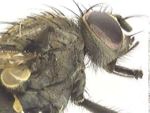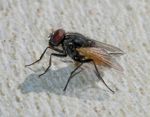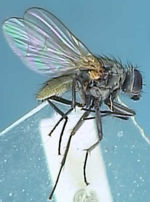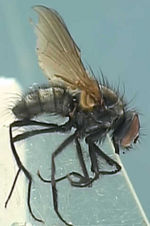Nuisance Flies
Revision as of 11:36, 11 November 2008 by Jtulloch (talk | contribs) (Nuisance Flies - WikiBlood moved to Nuisance Flies)
| This article is still under construction. |
|
|
Introduction
The family Muscidae contains many non-biting (nuisance) flies and blood sucking (biting) flies. There are only two nuisance flies of veterinary importance, these are the Musca spp. and Hydrotaea.
Nuisance flies are not only irritating to animals, but can also carry seious diseases and so shuld be controlled from an animal welfare point of view.
Musca spp.
- Also known as 'house' and 'face' flies
- Includes Musca domestica the house fly and Musca autumnalis the face fly
- Found in temperate regions
- The house fly is present both inside and outside of buildings
- The face fly is one of the most numerus flies which annoy cattle
- Attracted to the head and upper parts of the body
Recongnition
- 7.5mm long
- Sponge-like labellum mouthparts
- Grey thorax with longitudinal stripes
- Yellow abdomen with a single black stripe
Life Cycle
- Eggs laid in rotting manure, hatch and pass through pupal and larval stages before emerging
- Eggs hatch in 12 hours of being deposited
- Life cycle takes 12 days
- Flies may overwinter as adults
Pathogenesis
- Production losses
- Reduced weight gain
- Reduced milk yield
- Fly worry
- Disease transmission
- Viruses
- E.g. Coxsackie, enteroviruses, poliomyelitis
- Bacteria
- E.g. Anthrax, E.coli, Salmonella, Shigella, New Forest Eye Disease
- Helminths
- E.g. Intermediate hosts for Habronema in horses, some poultry tapeworms, Parafiliaria and Thelazia in cattle
- Viruses
- Feeds on secretions from the eyes, nose and mouth as well as blood left in wounds by other flies
Control
- Fly control in breeding and resting sites (to reduce the source)
- Breeding sites:
- Good santitation
- Collect dung in heaps
- Spray surface of heaps with insecticide to kill surviving adults and larvae
- Biological control
- Resting sites:
- Spray inside and outsides of buildings with insecticide
- Breeding sites:
- Fly control on the host
- Wide range of products available
- Nil or short withdrawal period needed for milking animals or animals going for slaughter
Hydrotaea irritans
- Also known as the 'head fly'
- Hydrotaea irritans the main species of veterinary importance
- Mainly a problem of sheep
- In some areas is the most numerous fly of cattle and horses
Recognition
- Similar to Musca spp.
- Olive green abdomen
- 4-7mm in length
Life Cycle
- Eggs laid in decaying vegetation, faeces and in carrion (in the summer months)
- Emerging larvae overwinter (diapause) and pupate in spring
- Adult flies emerge in the summer
- One generation per year
Pathogenesis
- Cattle:
- Head flies may transmit summer mastitis
- Sheep:
- Extreme irritation
- Mouthparts rasp the skin to feed on secretions and exudate
- Self-inflicted damage
- E.g. 'Broken Head'
- Secondary bacterial infection may occur
- Blowfly strike may follow
- Extreme irritation



